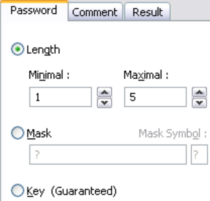Select the password fitting type in the “Password” tab of task properties (Fig. 4.1.1).

Figure 4.1.1 Password fitting type
Three variants are available:
- password recovery by length
- password recovery by mask
- document decryption by key
Select the minimal and maximal length of the password when using the first option (by length).
When using the second (by mask) input the mask and the mask character if necessary. If you already know some characters in the password, you can specify the mask to decrease the total number of passwords to be verified. At the moment, you can set the mask only for fixed-length passwords, but doing this can still help.
For example, you know that the password contains 8 characters, starts with 'x', and ends with '99'; the other symbols are small or capital letters. So, the mask to be set is "x?????99", and the charset has to be set to "Uppercase Latin Letters" and "Lowcase Latin Letters". With such options, the total number of the passwords that *EDPR* will try will be the same as if you're working with 5-character passwords which don't
contain digits; it is much less than if the length were set to 8 and the all "Character groups" check boxes were selected. In the above example, the '?' chars indicate the unknown symbols.
If you know that the password contains an occurrence of the mask character '?', you can choose a different mask character to avoid having one character, '?', represent both an unknown pattern position and a
known character. In this case, you could change the mask symbol from '?' to, for example, '#' or '*', and use a mask pattern of "x######?" (for mask symbol '#') or "x******?" (for mask symbol '*').
The third option needed for guaranteed document decryption.